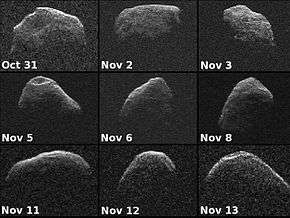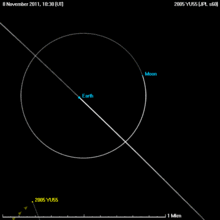List of asteroid close approaches to Earth
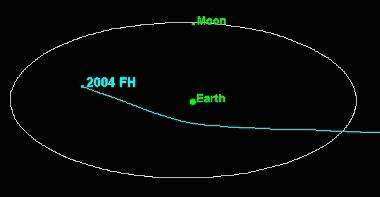
This is a list of examples where an asteroid or meteoroid travels close to the Earth. Some are regarded as potentially hazardous objects if they are estimated to be large enough to cause regional devastation.
Near-Earth object detection technology greatly improved around 1998, so objects being detected as of 2004 could have been missed only a decade earlier due to a lack of dedicated Near-Earth sky surveys. As dedicated Near-Earth sky surveys improve, smaller and smaller asteroids are regularly being discovered. The small near-Earth asteroids 2008 TC3 and 2014 AA are the only two asteroids discovered before impacting into Earth. Scientists estimate that several dozen asteroids in the 6 to 12 meter size range fly by Earth at a distance closer than the moon every year, but only a fraction of these are actually detected.[1]
Timeline of close approaches within one lunar distance to Earth
The average distance to the Moon (or LD) is about 384,400 km.[2] Below are lists of close approaches less than one LD for a given year. (See also near-Earth asteroids published by the International Astronomical Union[note 1] and NEO Earth Close Approaches.):
- List of asteroid close approaches to Earth in 2016
- List of asteroid close approaches to Earth in 2015
- List of asteroid close approaches to Earth in 2014
- List of asteroid close approaches to Earth in 2013
- List of asteroid close approaches to Earth in 2012
- List of asteroid close approaches to Earth in 2011
- List of asteroid close approaches to Earth in 2010
- List of asteroid close approaches to Earth in 2009
- List of asteroid close approaches to Earth in 2008
Closest per year
From the lists above, these are the closest known asteroids per year that approach Earth within one lunar distance LD and without impacting. More than one asteroid per year may be listed if its geocentric distance[note 2] is less than 0.10 LD. The table shows the year 2016 has five such close encounters. For comparison, since a satellite in a geostationary orbit has an altitude of about 36,000 km, then its geocentric distance is 0.11 LD.

| Year | Date of closest approach | Object | Nominal geocentric distance[note 3] (in thousand km) | Nominal geocentric distance (in LD) | Size of object (approx.) | (H) |
|---|---|---|---|---|---|---|
| 2017 | 2017-10-12 | 2012 TC4 | 14.4 | 0.037 | 10–31 meters | 26.7[3] |
| 2016 | 2016-02-25 | 2016 DY30 | 14.3 | 0.037 | 2–5 meters | 30.5[4] |
| 2016-09-11 | 2016 RN41 | 23.7 | 0.062 | 1–5 meters | 31.0[5] | |
| 2016-01-12 | 2016 AH164 | 26.7 | 0.069 | 3–7 meters | 29.6[6] | |
| 2016-03-11 | 2016 EF195[7] | 31.7 | 0.082 | 16–31 meters | 25.6[8] | |
| 2016-11-05 | XV88D4F | 36.7 | 0.095 | 2–7 meters | 30.0[9] | |
| 2016-01-14 | 2016 AN164 | 37.0 | 0.096 | 2–5 meters | 30.5[10] | |
| 2015 | 2015-09-22 | 2015 SK7 | 26.6 | 0.069 | 3–14 meters | 28.9[11] |
| 2015-11-15 | 2015 VY105 | 34.6 | 0.090 | 4–9 meters | 29.0[12] | |
| 2014 | 2014-06-03 | 2014 LY21 | 16.7 | 0.044 | 4–8 meters | 29.1[13] |
| 2013 | 2013-12-23 | 2013 YB | 27.3 | 0.071 | 3 meters | 31.4[14] |
| 2013-02-15 | 367943 Duende | 34.1 | 0.089 | 30 meters | 24.0[15] | |
| 2012 | 2012-05-29 | 2012 KT42 | 20.8 | 0.054 | 9 meters | 29.0[16] |
| 2011 | 2011-02-04 | 2011 CQ1[17] | 11.9 | 0.031 | 1 meter | 32.1[18] |
| 2011-06-27 | 2011 MD | 18.7 | 0.049 | 14 meters | 28.0[19] | |
| 2009 | 2009-11-06 | 2009 VA | 20.4 | 0.053 | 4–13 meters | 28.6[20] |
| 2008 | 2008-10-09 | 2008 TS26 | 12.6 | 0.033 | 0.5-1.6 meters | 33.2[21] |
| 2008-10-20 | 2008 US | 32.9 | 0.086 | 1–4 meters | 31.4[22] | |
| 2004 | 2004-03-31 | 2004 FU162 | 12.9 | 0.034 | 4–12 meters | 28.7[23] |
Notable cases are the relatively large asteroids 2016 EF195 and Duende, with the latter coincidentally approaching just a few hours after the unrelated Chelyabinsk meteor.
Largest per year
From the lists above, these are the largest known asteroids per year that approach Earth within one LD. (More than one asteroid per year may be listed if its size is 100 meters or more.) For comparison, the 2013 Chelyabinsk meteor which caused a large airburst over Russia was estimated to be just 20 meters across.
| Year | Date of closest approach | Object | Nominal geocentric distance (in thousand km) | Nominal geocentric distance (in LD) | Size of object (approx.) | (H) |
|---|---|---|---|---|---|---|
| 2016 | 2016-03-21 | 2016 FN56 | 384 | 1.00 | 35–86 meters | 24.2[24] |
| 2015 | 2015-01-18 | 2015 BP513 | 240 | 0.62 | 12–27 meters | 26.7[25] |
| 2014 | 2014-03-05 | 2014 DX110 | 349 | 0.91 | 20–40 meters | 25.7[26] |
| 2013 | 2013-08-04 | 2013 PJ10 | 371 | 0.97 | 60 meters | 24.6[27] |
| 2012 | 2012-04-01 | 2012 EG5 | 230 | 0.60 | 60 meters | 24.3[28] |
| 2011 | 2011-11-08 | (308635) 2005 YU55 | 324 | 0.84 | 360 meters | 21.9[29] |
| 2011-12-03 | 2011 XC2 | 347 | 0.90 | 100 meters | 23.1[30] | |
| 2010 | 2010-11-02 | 2010 UJ7 | 286 | 0.74 | 20–49 meters | 25.4[31] |
| 2009 | 2009-03-02 | 2009 DD45 | 72 | 0.19 | 15–47 meters | 25.8[32] |
| 2008 | 2008-02-15 | 2008 CK70 | 371 | 0.97 | 22–71 meters | 24.9[33] |
| 2007 | 2007-01-18 | 2007 BD | 324 | 0.84 | 18–57 meters | 25.4[34] |
| 2006 | 2006-02-23 | 2006 DD1 | 117 | 0.31 | 11–34 meters | 26.5[35] |
| 2005 | 2005-12-05 | 2005 XA8 | 217 | 0.57 | 15–49 meters | 25.7[36] |
| 2004 | 2004-03-18 | 2004 FH | 49 | 0.13 | 15–49 meters | 25.7[37] |
| 2003 | 2003-12-06 | 2003 XJ7 | 148 | 0.39 | 11–36 meters | 26.4[38] |
| 2002 | 2002-06-14 | 2002 MN | 120 | 0.31 | 40–130 meters | 23.6[39] |
| 2001 | 2001-01-15 | 2001 BA16 | 306 | 0.80 | 13–43 meters | 26.0[40] |
| 1999 | 1999-08-12 | 2016 CD137 | 179 | 0.47 | 13–43 meters | 26.0[41] |
| 1994 | 1994-12-09 | 1994 XM1 | 105 | 0.27 | 5–16 meters | 28.2[42] |
| 1993 | 1993-05-20 | 1993 KA2 | 149 | 0.39 | 3–11 meters | 29.0[43] |
| 1991 | 1991-04-08 | 2012 UE34 | 322 | 0.84 | 46–149 meters | 23.3[44] |
| 1990 | 1990-09-19 | 2003 SW130 | 186 | 0.48 | 3–10 meters | 29.1[45] |
| 1988 | 1988-10-16 | 2010 UK | 322 | 0.84 | 9–30 meters | 26.8[46] |
| 1982 | 1982-11-04 | 2012 TY52 | 314 | 0.82 | 111-358 meters | 21.4[47] |
| 1980 | 1980-05-18 | 2009 WW7 | 74 | 0.19 | 4-11 meters | 28.9[48] |
The year 2011 was notable as two asteroids with size 100 meters or more approached within one lunar distance.
Passed by outside of atmosphere
Objects with distances greater than 100 km are listed here, although there is no discrete beginning of space. The lists do not pretend to completeness.
Objects < 50 meters
Asteroids smaller than about 50 meters.[49]
| Nominal geocentric distance (AU) | Nominal geocentric distance (km) | Size (m) (approximate) | Date of closest approach | Object |
|---|---|---|---|---|
| 0.000079 | 11,900 | 1 | February 4, 2011 | 2011 CQ1[18] |
| 0.000084 | 12,500 | 1 | October 9, 2008 | 2008 TS26[21] |
| 0.000086 | 12,900 | 6 | March 31, 2004 | 2004 FU162 |
| 0.000125 | 18,700 | 10 | June 27, 2011 | 2011 MD[19][50] |
| 0.000137 | 20,400 | 7 | November 6, 2009 | 2009 VA |
| 0.000139 | 20,800 | 4–10 | May 29, 2012 | 2012 KT42 |
| 0.000177 | 26,500 | 3-14 | September 22, 2015 | 2015 SK7 |
| 0.00018 | 27,000 | 3 | December 23, 2013 | 2013 YB[51] |
| 0.000228 | 34,100 | 40×20[52] | February 15, 2013 | 367943 Duende[53][54] |
| 0.000260 | 38,900 | 3 | November 17, 2010 | 2010 WA[55] |
| 0.000328 | 49,100 | 30 | March 18, 2004 | 2004 FH |
| 0.000346 | 51,800 | 5–10 | October 12, 2010 | 2010 TD54 |
| 0.000383 | 57,300 | 25 | May 28, 2012 | 2012 KP24[56][57] |
| 0.000437 | 65,400 | 8 | January 27, 2012 | 2012 BX34 |
| 0.000482 | 72,100 | 9 | September 8, 2010 | 2010 RK53[58] |
| 0.000483 | 72,200 | 19 | March 2, 2009 | 2009 DD45 |
| 0.000484 | 72,400 | 2–7 | December 11, 2013 | 2013 XS21[59] |
| 0.000531 | 79,400 | 7 | September 8, 2010 | 2010 RF12[60] |
| 0.000564 | 84,300 | 5 | September 27, 2003 | 2003 SQ222[61] |
| 0.000568 | 85,000 | 15 | March 18, 2009 | 2009 FH[62] |
| 0.000635 | 95,000 | 17 | October 12, 2012 | 2012 TC4[63] |
| 0.000704 | 105,400 | 10 | December 9, 1994 | 1994 XM1[64][65] |
| 0.000862 | 129,000 | 15–30 | January 13, 2010 | 2010 AL30 |
| 0.000998 | 149,200 | 7 | May 20, 1993 | 1993 KA2[64][66] |
| 0.001124 | 168,200 | 6–10 | January 18, 1991 | 1991 BA |
| 0.001539 | 230,200 | 47 | April 1, 2012 | 2012 EG5[67] |
| 0.001655 | 247,600 | 12 | September 8, 2010 | 2010 RX30[68] |
| 0.002454 | 367,100 | 10–17 | March 4, 2013 | 2013 EC[69] |
| 0.00257 | 384,400 | average distance to the Moon[2] | ||
| 0.002899 | 433,600 | 22 | April 9, 2010 | 2010 GA6 |
Objects > 50 meters

Asteroids larger than about 50 meters.[49][70]
| Nominal geocentric distance (AU) | Nominal geocentric distance (km) | Size (m) (approximate) | Date of closest approach | Object |
|---|---|---|---|---|
| 0.000802 | 120,000 | 73 | June 14, 2002 | 2002 MN |
| 0.00155* | 233,000 | 500 | December 31, 1914 | (152680) 1998 KJ9 |
| 0.00159* | 239,000 | 200 | April 11, 1971 | 2002 JE9 |
| 0.00210* | 314,000 | 200 | November 4, 1982 | 2012 TY52 |
| 0.002172 | 324,900 | 360 | November 8, 2011 | (308635) 2005 YU55 |
| 0.00219* | 328,000 | 150 | October 17, 1976 | 2013 UG1 |
| 0.0022** | 329,000 | 100 | April 8, 1991 | 2012 UE34 |
| 0.0023* | 340,000 | 730 | August 30, 1925 | (163132) 2002 CU11 |
| 0.0023 | 340,000 | 100 | December 3, 2011 | 2011 XC2 |
| 0.00257 | 384,400 | average distance to the Moon[2] | ||
| <0.00266* | <398,000 | 100 | January 6, 1936 | 2010 VB1 |
| 0.002891 | 432,400 | 500 | July 3, 2006 | 2004 XP14 |
| 0.003704 | 554,200 | 250 | January 29, 2008 | 2007 TU24 |
| 0.004241* | 634,500 | 300 | April 26, 1942 | 69230 Hermes |
| 0.004572 | 684,000 | 300 | March 22, 1989 | 4581 Asclepius |
| 0.004950 | 740,500 | 300 | October 30, 1937 | 69230 Hermes |
| 0.0062* | 930,000 | 200 | December 27, 1976 | 2010 XC15 |
| 0.00836 | 1,251,000 | 325 | June 8, 2014 | 2014 HQ124 |
| 0.0093* | 1,390,000 | 5000 | August 27, 1969 | (192642) 1999 RD32 |
| 0.0124855 | 1,867,800 | 400 | December 16, 2001 | (33342) 1998 WT24 |
| 0.036415 | 5,447,600 | 1000 | June 14, 2012 | 2012 LZ1 |
| 0.043294 | 6,476,600 | 1600 | November 5, 2012 | (214869) 2007 PA8[71][72] |
| 0.046332 | 6,900,000 | 5400 | December 12, 2012 | 4179 Toutatis[73][74] |
Asteroids with large uncertainty regions are not included.
* Asteroid approach did NOT occur during an observed apparition. Passage is calculated by integrating the equations of motion.
** Only the nominal (best-fit) orbit shows a passage this close. The uncertainty region is still somewhat large due to a short observation arc.
Predicted encounters
Incomplete list of asteroids larger than about 50 meters predicted to pass close to Earth:[70][75]
| Nominal geocentric distance (AU) | Nominal geocentric distance (km) | Size (m) (approximate) | Date of closest approach | Object |
|---|---|---|---|---|
| 0.000256 | 38,300 | 325 | April 13, 2029 | 99942 Apophis |
| 0.000670 | 100,200 | 75–170 | October 19, 2129 | 2007 UW1 |
| 0.000721 | 107,800 | 50–120 | April 8, 2041 | 2012 UE34 |
| 0.001572 | 235,200 | 170–370 | January 2, 2101 | (456938) 2007 YV56[76] |
| 0.001585 | 237,000 | 360±40 | November 8, 2075 | (308635) 2005 YU55 |
| 0.001629 | 243,700 | 370–840 | December 1, 2140 | (153201) 2000 WO107 |
| 0.001635** | 244,600 | 190–420 | October 26, 2087 | 2011 WL2 |
| 0.001663 | 248,800 | 700–1500 | June 26, 2028 | (153814) 2001 WN5 |
| 0.001980 | 296,200 | 170–370 | January 22, 2148 | (85640) 1998 OX4[77] |
| 0.002222 | 332,500 | 190–250 | May 28, 2065 | 2005 WY55 |
| 0.002241 | 335,200 | 75–170 | March 23, 2146 | 2009 DO111 |
| 0.00257 | 384,400 | average distance to the Moon[2] | ||
A list of predicted NEO approaches at larger distances is maintained as a database by the NASA Near Earth Object Program.[78]
** Only the nominal (best-fit) orbit shows a passage this close. The uncertainty region is still somewhat large due to a short observation arc.
Earth grazers
.jpg)
Objects which enter and then leave Earth's atmosphere, the so-called 'Earth-grazers,' are a distinct phenomenon, in as much as entering the lower atmosphere can constitute an impact event rather than a close pass. Earth grazer can also be short for a body that "grazes" the orbit of the Earth, in a different context.
| Altitude (km) | Size (m) (approximate) | Mass (kg) (approximate) | Date of closest approach | Object | Note | Ref. |
|---|---|---|---|---|---|---|
| 0 | mean sea level | |||||
| 8.8 | Mount Everest (height) | |||||
| 58 | 5 | 105–106 | August 10, 1972 | 1972 Great Daylight Fireball above the United States and Canada | First scientifically observed | [79] |
| 71.4 | 100 | March 29, 2006 | 2006 Earth-grazing Fireball above Japan | |||
| 98.7 | 44 | October 13, 1990 | 1990 Earth-grazing Fireball above Czechoslovakia and Poland | First captured from 2 distant locations, which enabled computing its orbit by geometrical methods | [81] | |
| August 7, 2007 | 2007 Earth-grazing Fireball | Its pre-encounter orbit belonged to the rare Aten type. | [82] | |||
| 100 | Kármán line | |||||
Animation
Here is simulated animation of the course of 2015 TB145, a NEO during close approach to the Earth
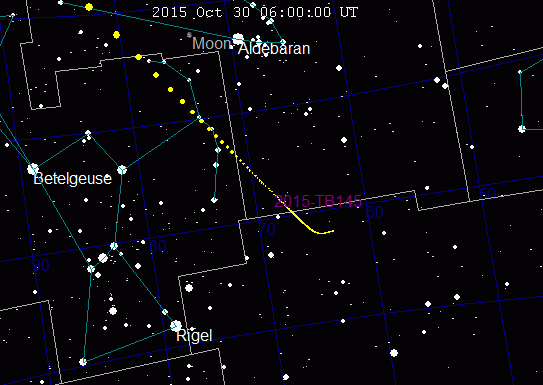 An animation of the flyby, as seen from the center of the Earth, with hourly trace circles along the path of motion |
Overview
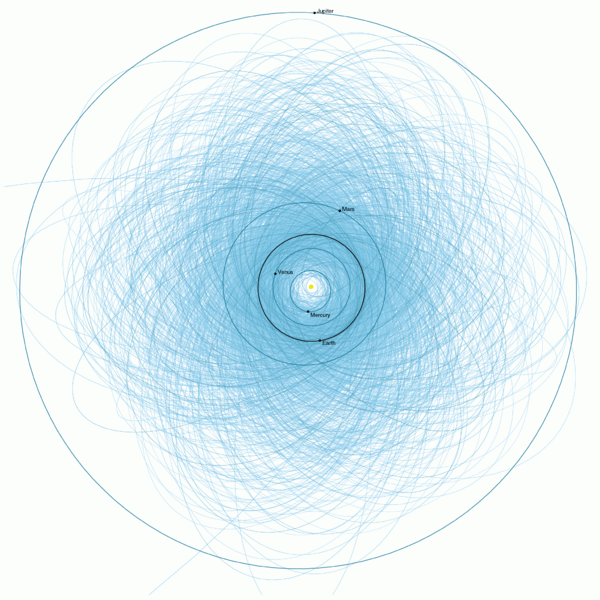
Notes
- ↑
- ↑ Distance from the center of Earth to the center of the object. See the NASA/JPL Solar System Dynamics Glossary: Geocentric. Earth has a radius of approximately 6,400 km.
- ↑ Distance from the center of Earth to the center of the object. See the NASA/JPL Solar System Dynamics Glossary: Geocentric. Earth has a radius of approximately 6,400 km.
References
- ↑ Responding to Potential Asteroid Redirect Mission Targets
- 1 2 3 4 NASA Staff (10 May 2011). "Solar System Exploration: Planets: Earth's Moon: Facts & Figures". NASA. Retrieved 6 November 2011.
- ↑ "JPL Small-Body Database Browser: (2012 TC4)" (last observation: 2012-10-11).
- ↑ "JPL Small-Body Database Browser: (2016 DY30)" (last observation: 2016-02-27).
- ↑ "JPL Small-Body Database Browser: (2016 RN41)" (last observation: 2016-09-11).
- ↑ "JPL Small-Body Database Browser: (2016 AH164)" (last observation: 2016-01-13).
- ↑ "Small asteroid detected 4 days after passing as close as satellites".
- ↑ "JPL Small-Body Database Browser: (2016 EF195)" (last observation: 2016-03-17).
- ↑ With an arc of 1.5 hours and 6 observations, there is a roughly 40% chance it passed further than 0.1 LD, with a maximum distance of 0.13 LD.
- ↑ "JPL Small-Body Database Browser: (2016 AN164)" (last observation: 2016-01-14).
- ↑ "JPL Small-Body Database Browser: (2015 SK7)" (last observation: 2015-10-13).
- ↑ "JPL Small-Body Database Browser: (2015 VY105)" (last observation: 2015-11-15).
- ↑ "JPL Small-Body Database Browser: (2014 LY21)" (last observation: 2014-06-02).
- ↑ "JPL Small-Body Database Browser: (2013 YB)" (last observation: 2013-12-23).
- ↑ "JPL Small-Body Database Browser: 367943 Duende (2012 DA14)" (last observation: 2013-02-21).
- ↑ "JPL Small-Body Database Browser: (2012 KT42)" (2012-05-29 last obs).
- ↑ Yeomans, Don; Chodas, Paul (4 February 2011). "Very Small Asteroid Makes Close Earth Approach on February 4, 2011". Near-Earth Object Program Office. NASA/JPL. Retrieved 22 February 2013.
- 1 2 "JPL Small-Body Database Browser: (2011 CQ1)" (2011-02-04 last obs).
- 1 2 "JPL Small-Body Database Browser: (2011 MD)" (2011-07-03 last obs (arc=12 days)).
- ↑ "JPL Small-Body Database Browser: (2009 VA)" (last observation: 2009-11-06).
- 1 2 "JPL Small-Body Database Browser: (2008 TS26)" (last observation: 2008-10-09).
- ↑ "JPL Small-Body Database Browser: (2008 US)" (last observation: 2008-10-21).
- ↑ FU162;cad=1#cad "JPL Small-Body Database Browser: (2004 FU162)" Check
|url=value (help) (last observation: 2004-03-31). - ↑ "JPL Small-Body Database Browser: (2016 FN56)" (last observation: 2016-04-05).
- ↑ "JPL Small-Body Database Browser: (2015 BP513)" (last observation: 2015-01-29).
- ↑ "JPL Small-Body Database Browser: (2014 DX110)" (last observation: 2014-03-05).
- ↑ "JPL Small-Body Database Browser: (2013 PJ10)" (last observation: 2013-09-09).
- ↑ "JPL Small-Body Database Browser: (2012 EG5)" (2012-04-03 last obs).
- ↑ "JPL Small-Body Database Browser: (2005 YU55)" (2011-12-16 last obs).
- ↑ "JPL Small-Body Database Browser: (2011 XC2)" (2011-12-30 last obs (arc=22 days)).
- ↑ "JPL Small-Body Database Browser: (2010 UJ7)" (last observation: 2010-11-02).
- ↑ "JPL Small-Body Database Browser: (2009 DD45)" (last observation: 2009-03-06).
- ↑ "JPL Small-Body Database Browser: (2008 CK70)" (last observation: 2008-02-14).
- ↑ "JPL Small-Body Database Browser: (2007 BD)" (last observation: 2007-01-20).
- ↑ "JPL Small-Body Database Browser: (2006 DD1)" (last observation: 2006-02-23).
- ↑ "JPL Small-Body Database Browser: (2005 XA8)" (last observation: 2005-12-24).
- ↑ "JPL Small-Body Database Browser: (2004 FH)" (last observation: 2004-03-19).
- ↑ "JPL Small-Body Database Browser: (2003 XJ7)" (last observation: 2003-12-06).
- ↑ "JPL Small-Body Database Browser: (2002MN)" (last observation: 2002-08-09).
- ↑ "JPL Small-Body Database Browser: (2001BA16)" (last observation: 2001-01-15).
- ↑ "JPL Small-Body Database Browser: (2016 CD137)" (last observation: 2016-02-18).
- ↑ "JPL Small-Body Database Browser: (1994 XM1)" (last observation: 1994-12-09).
- ↑ "JPL Small-Body Database Browser: (1993 KA2)" (last observation: 1993-05-22).
- ↑ "JPL Small-Body Database Browser: (2012 UE34)" (last observation: 2013-07-05).
- ↑ "JPL Small-Body Database Browser: (2003 SW130)" (last observation: 2003-09-28).
- ↑ "JPL Small-Body Database Browser: (2010 UK)" (last observation: 2011-11-01).
- ↑ "JPL Small-Body Database Browser: (2012 TY52)" (last observation: 2015-04-17).
- ↑ "JPL Small-Body Database Browser: (2009 WW7)" (last observation: 2009-11-23).
- 1 2 "Closest Approaches to the Earth by Minor Planets". International Astronomical Union/Minor Planet Center. Retrieved 12 February 2013.
- ↑ Benner, Lance A. M. "2011 MD Goldstone Radar Observations Planning". Asteroid Radar Research. JPL/California Institute of Technology. Retrieved 22 February 2013.
- ↑ "JPL Small-Body Database Browser: (2013 YB)" (2013-12-23 last obs). Retrieved 2013-12-24.
- ↑ Benner, Lance A. M. "2012 DA14 Goldstone Radar Observations Planning". Asteroid Radar Research. JPL/California Institute of Technology. Retrieved 20 February 2013.
- ↑ "NEOs Removed from Impact Risk Tables". Near-Earth Object Program Office. NASA/JPL. Retrieved 17 February 2013.
- ↑ "JPL Small-Body Database Browser: (2012 DA14)" (2013-02-16 last obs). Retrieved 17 February 2013.
- ↑ "JPL Small-Body Database Browser: (2010 WA)" (2010-11-17 last obs). Retrieved 12 February 2013.
- ↑ "JPL Small-Body Database Browser: (2012 KP24)" (2012-05-28 last obs). Retrieved 16 February 2013.
- ↑ Plait, Phil (25 May 2012). "Small asteroid to buzz Earth on May 28". Discover. Retrieved 16 February 2013.
- ↑ "JPL Small-Body Database Browser: (2010 RK53)" (2010-09-17 last obs). Retrieved 1 March 2013.
- ↑ "JPL Small-Body Database Browser: (2013 XS21)" (2013-12-14 last obs).
- ↑ "2010 RF12 Earth Impact Risk Summary". Near-Earth Object Program Office. NASA/JPL. Retrieved 12 February 2013.
- ↑ "JPL Small-Body Database Browser: (2003 SQ222)" (2003-10-02 last obs). Retrieved 12 February 2013.
- ↑ "JPL Small-Body Database Browser: (2009 FH)" (2009-03-18 last obs). Retrieved 1 March 2013.
- ↑ "JPL Small-Body Database Browser: (2012 TC4)" (2012-10-11 last obs). Retrieved 12 February 2013.
- 1 2 Williams, David R. "Near Earth Object Fact Sheet". Lunar & Planetary Science. NASA Goddard Space Flight Center. Retrieved 17 February 2013.
- ↑ "JPL Small-Body Database Browser: (1994 XM1)" (1994-12-09 last obs). Retrieved 17 February 2013.
- ↑ "JPL Small-Body Database Browser: (1993 KA2)" (1993-05-22 last obs). Retrieved 17 February 2013.
- ↑ "JPL Small-Body Database Browser: (2012 EG5)" (2012-04-03 last obs). Retrieved 1 March 2013.
- ↑ "JPL Small-Body Database Browser: (2010 RX30)" (2010-09-08 last obs).
- ↑ "JPL Small-Body Database Browser: (2013 EC)" (2013-03-03 last obs). Retrieved 4 June 2015.
- 1 2 "NEO Earth Close-Approaches (Between 1900 A.D. and 2200 A.D., NEOs with H <=22, nominal distance within 5 LD)". Near-Earth Object Program Office. NASA/JPL. Retrieved 17 May 2015.
- ↑ Benner, Lance A. M. "(214869) 2007 PA8 Goldstone Radar Observations Planning". Asteroid Radar Research. JPL/California Institute of Technology. Retrieved 14 February 2013.
- ↑ "JPL Small-Body Database Browser: 214869 (2007 PA8)" (2013-02-13 last obs). Retrieved 15 February 2013.
- ↑ "JPL Small-Body Database Browser: 4179 Toutatis (1989 AC)" (2012-12-08 last obs). Retrieved 12 February 2013.
- ↑ Atkinson, Nancy (11 December 2012). "Two Asteroids Will Buzz Past Earth on December 11". Universe Today. Retrieved 12 February 2013.
- ↑ "PHA Close Approaches To The Earth". International Astronomical Union/Minor Planet Center. Retrieved 14 November 2011.
- ↑ "JPL Small-Body Database Browser: (2007 YV56)" (2012-01-29 last obs). Retrieved 17 February 2013.
- ↑ "JPL Small-Body Database Browser: 85640 (1998 OX4)" (2008-07-29 last obs). Retrieved 17 February 2013.
- ↑ NASA, Near Earth Object Program, database NEO Earth Close-Approaches Between 1900 A.D. and 2200 A.D. limited to encounters with reasonably low uncertainty (accessed 20 Sept. 2013)
- ↑ Ceplecha, Z. (March 1994). "Earth-grazing daylight fireball of August 10, 1972" (PDF). Astronomy and Astrophysics. 283 (1): 287–288. Bibcode:1994A&A...283..287C. ISSN 0004-6361. Retrieved 2015-03-14.
- ↑ S., Abe; J., Borovička; P., Spurný; P., Koten; Z., Ceplecha; Meteor Network Team in Japan (18–22 September 2006). "Earth-grazing fireball on March 29, 2006". European Planetary Science Congress 2006. Berlin. p. 486. Bibcode:2006epsc.conf..486A. Retrieved 2015-03-14.
- ↑ Borovička, J.; Ceplecha, Z. (April 1992). "Earth-grazing fireball of October 13, 1990". Astronomy and Astrophysics. 257 (1): 323–328. Bibcode:1992A&A...257..323B. ISSN 0004-6361. Retrieved 2015-03-14.
- ↑ Spurný, P.; Borovička, J.; Ceplecha, Z.; Shrbený, L. (2008), "Precise Multi-Instrument Data on 45 Fireballs Recorded over Central Europe in the Period 2006-2008" (PDF), Asteroids, Comets, Meteors 2008 held July 14–18, 2008 in Baltimore, Maryland, Bibcode:2008LPICo1405.8217S, retrieved 2015-03-14
External links
- Sentry Risk Table — Jet Propulsion Laboratory
- "PHA Close Approaches To The Earth" — Minor Planet Center
- "NEO Earth Close Approaches" — NASA/JPL's Near-Earth Object Program Office
- "NEO Earth Close-Approaches" (Between 1900 A.D. and 2200 A.D., NEOs with H <=22, nominal distance within 5 LD) — NASA/JPL's Near-Earth Object Program Office
- "Near Earth Asteroids (NEAs): A Chronology of Milestones" — International Astronomical Union
- NEODyS-2 — Near Earth Objects Dynamic Site sponsored by ESA
- TECA Table of asteroids next close approaches to the Earth — Sormano Astronomical Observatory
- SAEL Small Asteroids Encounter List — Sormano Astronomical Observatory
- E.A.R.N. — European Asteroid Research Node
- Upcoming Close Approaches (< 0.10 AU) of NEOs to the Inner Planets - Andrew Lowe using Solex 11
- Earth's Busy Neighborhood — HohmannTransfer
- NASA Astronomy Picture of the Day: Earthgrazer: The Great Daylight Fireball of 1972 (2 March 2009)
